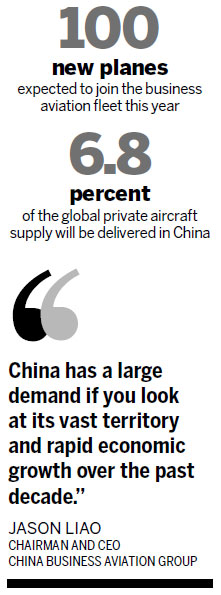Aviation Special: Rising demand for corporate jets, but headwind remains
Updated: 2013-04-16 07:58
By Li Fusheng (China Daily)
|
||||||||

Business aviation is poised to climb to new heights in China as a combination of factors in the world's second-largest economy set the stage for more private aircraft in China, say industry insiders.
The number of business aircraft in China has risen from 109 in 2011 to more than 170 at the end of last year, said Jason Liao, CEO and chairman of China Business Aviation Group, a major business aircraft dealer in the country.
Liao expects another 100 to join the country's business fleet in 2013.
"China has a large demand if you look at its vast territory and rapid economic growth over the past decade," he said.
But an even bigger driver of the burgeoning business aircraft market, is more support from the country's civil aviation authorities.
Among other things, the authorities have cut the time required for approval of private flights from one week a decade ago to one day or even several hours today.
"Besides, we are drafting specific rules to regulate business aviation. Various improvement measures and industry layouts are also underway to clear obstacles impeding its development," Xia Xinghua, deputy-director of the Civil Aviation Administration of China, said at the 2012 Asian Business Aviation Conference & Exhibition.
Reports say that by 2020 China plans to build another 280 airports for general aviation, 40 of them serving business aircraft.
Xia estimates the number of business planes in China could reach 260 by the end of the 12th Five-Year Plan (2011-15).
Leading aircraft manufacturers are even more optimistic.
Brazilian aerospace conglomerate Embraer predicts in a report on its website that 470 private aircraft will be delivered to China from 2010 to 2020, accounting for 6.8 percent of the global market and making the country the second-largest after the US.
Bombardier, Embraer's Canadian rival, says that the number of business jets in China could increase to 2,470 in 2030.
Despite the bright prospects, insiders say there are still impediments to the industry's development.
"The biggest obstacle is that the public still clings to the outdated idea that business aircraft are luxuries," Liao said.
"Though expensive, they are not bought to show off - but to save time," he said.
His comments were echoed by Ed Bolen, president and CEO of the US National Business Aviation Association.
"Organizations all over the world have the same amount of time in each day. Business airplanes help governments and companies use that time efficiently and productively," said Bolen.
By saving time and increasing productivity, business aviation has enabled companies of all sizes to be more competitive and to grasp new opportunities, he added.
Other challenges to the industry's growth in China include high taxes, a lack of trained pilots and maintenance technicians, and inadequate infrastructure.
The government now imposes a 17 percent value-added tax and a 5 percent tariff on imported jets.
Liao said it would help spur the development of business aviation in China if the government could ease the heavy burden on buyers.
In addition, China has had a shortage of airports and fixed operating bases serving business aircraft since the surge in the sector began in 2009.
"We need the support of local authorities so that business aircraft can have access to enhanced ground services," Liu Zijing, chairman of China Civil Airport Association, told Xinhua news agency.
lifusheng@chinadaily.com.cn
(China Daily 04/16/2013 page14)

 In Photos: 7.0-magnitude quake hits Sichuan
In Photos: 7.0-magnitude quake hits Sichuan
 Li Na on Time cover, makes influential 100 list
Li Na on Time cover, makes influential 100 list
 FBI releases photos of 2 Boston bombings suspects
FBI releases photos of 2 Boston bombings suspects
 World's wackiest hairstyles
World's wackiest hairstyles
 Sandstorms strike Northwest China
Sandstorms strike Northwest China
 Never-seen photos of Madonna on display
Never-seen photos of Madonna on display
 H7N9 outbreak linked to waterfowl migration
H7N9 outbreak linked to waterfowl migration
 Dozens feared dead in Texas plant blast
Dozens feared dead in Texas plant blast
Most Viewed
Editor's Picks

|

|

|

|

|

|
Today's Top News
Live report: 7.0-magnitude quake hits Sichuan, heavy casualties feared
Boston suspect cornered on boat
Cross-talk artist helps to spread the word
'Green' awareness levels drop in Beijing
Palace Museum spruces up
First couple on Time's list of most influential
H7N9 flu transmission studied
Trading channels 'need to broaden'
US Weekly

|

|







